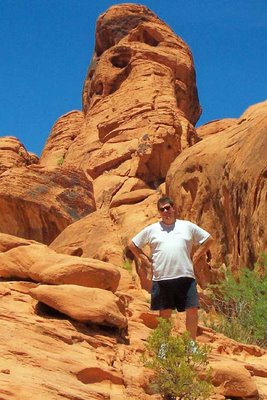
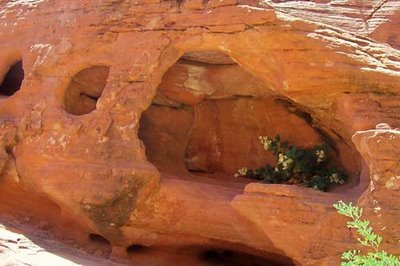
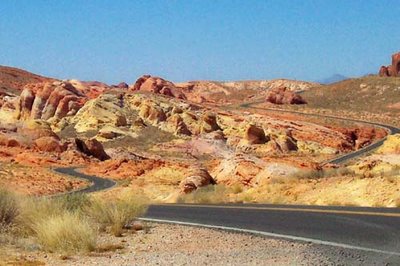

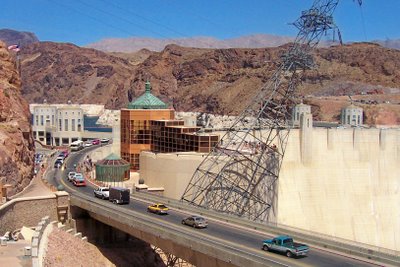
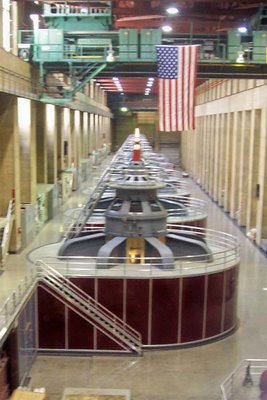 SIX FROM THE DUSTY ROAD: The top two photos are from the Mouse's Tank in the Valley of Fire, with your correspondent out under the hot sun, but with the flowers shaded from this oppresive desert heat. The third is a look at the roadways winding through the picturesque park, the fourth is a peek at some petroglyphs which are all over this area; Second from the bottom is a look at the Hoover Dam complex from the western approach with the Dam on the right and Lake Mead in the background; and at bottom is a look at the huge power turbines deep inside the Dam, that are hundreds of feet deep and turned by the powerful Colorado River's waters.
SIX FROM THE DUSTY ROAD: The top two photos are from the Mouse's Tank in the Valley of Fire, with your correspondent out under the hot sun, but with the flowers shaded from this oppresive desert heat. The third is a look at the roadways winding through the picturesque park, the fourth is a peek at some petroglyphs which are all over this area; Second from the bottom is a look at the Hoover Dam complex from the western approach with the Dam on the right and Lake Mead in the background; and at bottom is a look at the huge power turbines deep inside the Dam, that are hundreds of feet deep and turned by the powerful Colorado River's waters.VALLEY AND
THE DAMMED
As I told you in my last post, the visit to Las Vegas was sandwiched between two other short journeys of discovery:
Fire at Will...
The Valley of Fire State Park is almost 35,000 acres of Hollywood-quality scenery.
Lying about 50 miles northeast of Las Vegas in the Mojave Desert, the Valley of Fire was Nevada’s first state park. The area is so named because when the sun shines brightly, reflecting off of the eroded sandstone and sand dunes - some more than 150 million years old, it appears as if it’s on fire.
Hollywood discovered this circumstance years ago and has taken full advantage of this fact. Recent big-budget films that have used this area for background are Romancing The Stone, Broken Arrow, Viva Las Vegas, Duets, Star Trek Generations, 1,000,000,000 B.C., The Stand, Fools Rush In and Domino.
MTV exploited it on Real World, American Idols have sung here. So have some Country Music stars and a former Go-Go.
Just take a look at the photo above of the roadway through the park and you know many, many car commercials have been filmed here. And that many, many more will be.
On the way to Las Vegas, I broke away from the highway and headed south through the desert and into this dreamscape. Very glad I did, even if it was well over 100 degrees in the park.
The unique geological features here include The Beehives, massive rocks shaped like its names just inside the west entrance; the Mouse’s Tank (see above), a series of slot canyons stuffed with wildflowers and petroglyphs which a renegade Indian used as a hideout as late as the 1890s; and the White Domes, a series of sandstone formations at the far end of the park. A favorite area for the Tinseltown crowd, the winding up-and-down trail here goes through some slot canyons so narrow I had to turn sideways to get through them.
Among the many other wonders here was the Atlatl Rock (see above), site of many Indian petroglyphs, dating back from 300 BC to 1150 AD.
This is some wildlife here, jackrabbits, coyotes, foxes, lizards and snakes, among others, but you won't see them until after sundown. There’s a lot of cacti as well as some desert bush. You might spy a raven in flight, or a roadrunner. Might not.
There is a Visitor’s Center with varied exhibits. Camping is available at two campgrounds within the park. The 51 spots have sheltered picnic tables, grills and water at each site with restrooms and showers available. I didn’t camp here but, to be honest, I wouldn’t be caught out here in a tent. Camping here seems to me to be only for RVs and trailers. Winters are mild but, in the summer, the temperatures can rise to 120 degrees. There is very little cover here, except the rocks and their shadows. Don’t get me wrong. This place is well worth visiting – a visual marvel. Just come prepared.
For more, call the ranger at 702-397-2088.
Dammed if I do...
After a night spent wandering the Strip in Las Vegas, I drove about 30 miles to the southeast, out to the Nevada-Arizona border and the Hoover Dam.Built on the Colorado River during the Great Depression, in the short term this massive construction project supplied jobs for struggling people from all over the country and in the long term provided water and power for seven western states, controlled a dangerous flood threat and created the nations fifth busiest National Park at Lake Mead behind the Dam. Here’s a brief breakdown:
It took just under five years to build (April 20, 1931 to March 1, 1936).
The Dam itself cost $49 million to complete ($676 million adjusted for inflation), although the Bechtel Corp. was involved here too (one of the six major contractors), warming up its accounting department for the Big Dig. The total project’s cost, including the preparation for all the surrounding areas, was $165 million. That debt to the Federal Treasury has been completely retired, with interest, from proceeds of the sale of its power to the individual states.
Ninety-six deaths are attributed directly to the Dam’s construction, while there were 107 totals deaths among the workers (others due to sickness, etc.). In a strange twist, the first worker killed was the father of the last man who died. The father lost his life in a construction accident while the son, also employed at the Dam, committed suicide by leaping off the top of the Dam after it was completed. The son killed himself 22 years to the day after his father died -- just in time for the holidays -- on Dec. 20.
The dam is 726 feet high, 1,244 feet long, and 45 feet thick at the top and 660 feet thick at the bottom.
Workers poured 4,360,000 cubic yards of concrete, enough for a four-foot wide sidewalk around the equator or a four-lane highway from New York City to Los Angeles.
The Dam directs water to 18 million people in the Southwest and provides irrigation for countless farms in the area. The electricity produced here is enough to satisfy the needs of 1.3 million customers a day, with Southern California receiving the lion’s share of the volts at 56 percent.
13,000 to 16,000 people use the road atop the dam each day and there are over a million visitors a year to the complex.
Lake Mead, created by the Dam is 157,900 acres in area and 500 feet deep. The lake backs up 110 miles behind the dam, with 550 miles of shoreline.
Originally called the Boulder Dam, it was later named after President Herbert Hoover, acknowledged as a visionary in matters of grand infrastructure, who pushed for this project way back when he was Secretary of Commerce.
It was 106 degrees atop the dam, but I still spent six hours touring this fascinating area, from the construction trams hanging over the top to the power turbines deep inside the complex. They give a great tour here, the real nuts and bolts, and also have a Visitor Center with lots of interactive exhibits.
As many as 5,000 people a day tour this place and, in the crowd that day, deep underground in a corridor leading to the power turbines, I spied several Red Sox hats.
There is an monument area outside on the top deck which, along with a grand statue and several plaques, describes the Dam in scientific as wall as esoteric terms, Confused by this, I asked a tour guide about it and was told that these signs and drawings are for future generations, or visitors from another planet even, who may stumble upon this place in the eons to come. This project is so impressive, the builders wanted to boost about it to Little Green Men.
You walk around here, you see what was built all while taming of a powerful wild river and you can’t helped but be inspired about what mankind can do if it puts its mind to it. Anything is possible …
For more, go to http://www.hooverdam.usbr.gov/ .


No comments:
Post a Comment